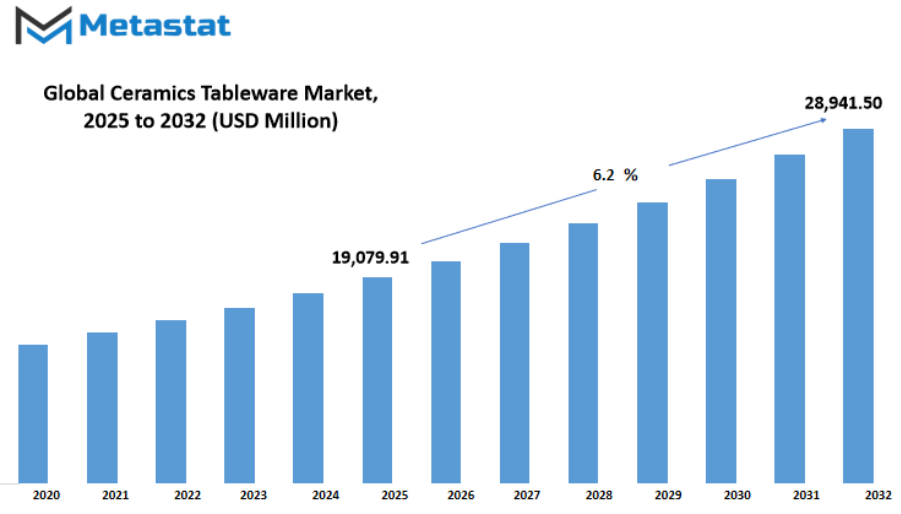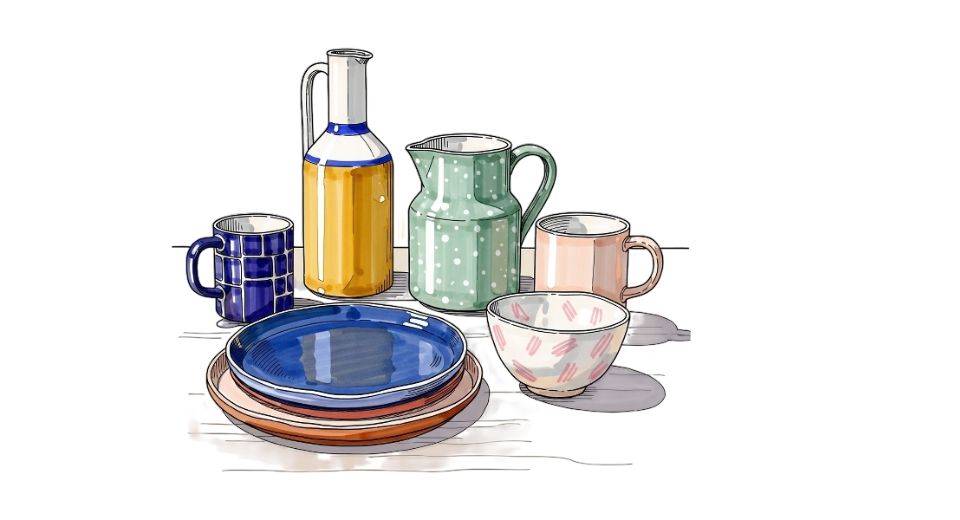MARKET OVERVIEW
The global ceramics tableware market is part of the overall tableware industry and involves products manufactured from ceramic materials such as porcelain, stoneware, and earthenware. The industry will continue serving consumers, restaurants, hotels, and catering establishments that appreciate strength, heat retention, and an attractive appearance in food consumption. Ceramic tableware will continue to be distinguished from others like glass, plastic, or metal by its ability to create a relationship of form and function through the synthesis of traditional art of craftsmanship with newer manufacturing technologies.
The global ceramics tableware market in the next few years will be shaped by the evolving dining culture patterns, advances in production technology, and the impact of international trade. While ceramics have been around for centuries, the industry will keep evolving to match the evolving lifestyle and consumer trends. The manufacturers will be creating new glazing techniques, more environmentally friendly production methods, and designs appealing to minimalists as well as the fans of intricate patterns. This will create a setting where heritage-pattern designs merge with minimalist, modern forms that are beautiful in modern dining rooms.
The global ceramics tableware market will be giving up more than just utility. To others, ceramic tableware will be a statement of style or status, especially where presentation at the table is as crucial as the meal that the table sets. To hospitality businesses, tabletop decisions will still be part of brand image and visitor experience. At home, home use ceramic tableware will be purchased, yes, but also for holidays, for gift, and to decorate seasonally. Across the globe, markets will be connected, design ideals winging their way across the planet in a split second.
A design piece made in an European design studio can be found in Asian homes within months, and Asian design will influence motifs and shapes adopted in Western markets. All these cross-cultural interactions will render product lines dynamic, making manufacturers work day and night to innovate. At the same time, the market will face problems like maintaining consistency of quality by quantity, following safety measures in different countries, and adapting to variability in availability of raw materials. E-commerce will also rule the roost in the global ceramics tableware market.
Web sites will provide small artisans an opportunity to connect with customers worldwide without investing billions in distribution systems. The shift will not kill bricks-and-mortar stores, but it will provide consumers with more choice if they want to purchase customized or hand-made products rather than mass-produced ones. Customers in the future will be able to view how a specific arrangement of dinners would appear on their dining table courtesy of virtual showrooms and augmented reality software before making a purchase. In essence, this market will not be defined by a single trend or style, but by how far it is able to move with the changing lifestyle without losing the things that have made ceramics a staple on the table for thousands of years. With the changes in technology and society, so will the products, the designs, and the experiences being produced, and ceramic tableware will remain handy in utility and aesthetic purposes.
Global ceramics tableware market is estimated to reach $28,941.50 Million by 2032; growing at a CAGR of 6.2% from 2025 to 2032.

GROWTH FACTORS
The global ceramics tableware market is expected to witness steady growth in the years ahead as changing lifestyles and consumer aspirations reshape dining habits. Rising disposable incomes across many regions are allowing more households to invest in stylish tableware that complements their home décor. Social media platforms, with their constant display of aesthetically arranged dining setups, have created a culture where presentation is as valued as the food itself. This visual influence has made elegant and well-designed ceramic tableware not only a functional choice but also a statement of personal style. As more people entertain guests at home, the demand for distinctive and fashionable pieces will continue to expand.
The growth of the hospitality and food-service sectors will also play a significant role in fueling demand. Restaurants, hotels, and catering services are investing in premium ceramic collections to enhance the dining experience and reflect their brand identity. Bulk purchases by these establishments can significantly drive sales, especially in the premium segment where design, durability, and craftsmanship matter most. As global travel and dining resume strong growth, the need for high-quality tableware in large quantities is expected to rise.
Despite these positive drivers, the global ceramics tableware market will face certain challenges. Cost-sensitive consumers may turn to cheaper alternatives like plastic and melamine, especially in markets where price outweighs aesthetic value. These substitutes can be more affordable and easier to produce, making them attractive for some buyers. Furthermore, the ceramic production process itself can be costly. Kiln operations require significant energy, and skilled artisans are needed to create high-quality designs. Rising energy prices and labor costs can put pressure on manufacturers and limit profit margins.
Looking ahead, a shift in consumer priorities may open new opportunities. Many buyers are showing stronger interest in eco-friendly, lead-free ceramics that are safe for both people and the environment. Artisanal pieces, often handmade and customizable, are gaining popularity as consumers look for unique designs that stand out from mass-produced items. Brands that focus on sustainability and personalization will be well positioned to capture this growing segment.
In the future, as awareness of environmental issues continues to spread and consumers place greater value on individuality, the global ceramics tableware market will likely move toward products that balance beauty, function, and ethical production. This combination of social trends, industry expansion, and shifting consumer values suggests that the market’s potential remains strong, even as it adapts to challenges and competition.
MARKET SEGMENTATION
By Type
The global ceramics tableware market is moving toward a future shaped by changing lifestyles, design trends, and technological advancements in manufacturing. As people continue to seek both beauty and function in the items they use every day, ceramics tableware remains a preferred choice for households, restaurants, and the hospitality sector. This market, by type, is further segmented into porcelain and bone china, stoneware (ceramic), and other types. Each of these has its own appeal and purpose, and together they form a broad range of options for consumers across the world.
Porcelain and bone china are valued for their delicate appearance and refined feel, yet they also offer durability that makes them practical for regular use. In the future, these materials will likely be produced with improved strength and lighter weight, meeting the growing demand for products that are both elegant and easy to handle. Advances in glazing and finishing techniques will allow for more creative patterns and longer-lasting designs, making them attractive for premium and gift-oriented purchases.
Stoneware, which is known for its sturdiness and rustic appeal, is expected to gain more attention as consumers embrace casual dining and relaxed presentation styles. Manufacturers are likely to focus on creating stoneware with unique textures, earthy tones, and sustainable production methods. As eco-conscious choices become more important, stoneware could be made with recycled materials and energy-efficient processes, appealing to buyers who want both quality and responsibility in their purchases.
Other types of ceramics tableware, which may include earthenware or newer experimental blends, will also play a role in the market’s growth. These options could bring innovation in both design and performance, offering features such as higher resistance to chipping or even self-heating capabilities through embedded technology. Such advancements will open possibilities for everyday convenience while keeping the traditional charm that ceramics bring to the table.
Looking ahead, the global ceramics tableware market will continue to be influenced by urbanization, shifting cultural preferences, and the blending of traditional craftsmanship with modern techniques. The ability to customize pieces for personal or commercial branding will further enhance their value. Digital tools such as 3D printing will enable intricate shapes and personalized orders, reducing waste and production costs. As dining experiences become more about visual appeal and personal expression, ceramics tableware will hold an even more prominent place in both home and professional settings. This combination of heritage, technology, and style will ensure that ceramics remain a central part of how people share meals and moments in the years to come.
By Distribution Channel
The global ceramics tableware market is expected to see steady growth as lifestyles change and consumer preferences shift toward products that combine practicality with style. By distribution channel, the market is divided into supermarkets and hypermarkets, specialty stores, wholesalers, online platforms, and other outlets. Each channel plays a distinct role in shaping the future of this industry, offering consumers different ways to purchase items based on convenience, variety, and price.
Supermarkets and hypermarkets will continue to be a strong channel, as they allow customers to physically examine products before making a purchase. These large retail spaces often attract buyers who prefer immediate availability and the option to compare multiple brands side by side. Their wide reach also makes them an effective channel for introducing new designs and seasonal collections. In the coming years, improvements in store displays and interactive product information may make these outlets even more appealing to buyers.
Specialty stores are likely to maintain their relevance by focusing on quality, craftsmanship, and personalized service. They often cater to customers looking for unique or high-end pieces, which means they can influence trends in design and materials. As people increasingly value distinctive tableware that reflects their personal style, these stores may benefit from offering limited-edition collections and in-store customization services.
Wholesalers play a different role, supplying bulk quantities to restaurants, hotels, and catering services. This channel will remain essential as the hospitality sector grows worldwide, particularly in regions where tourism is expanding. Future developments could include more eco-friendly packaging and faster delivery systems, enabling wholesalers to meet rising demand efficiently.
Online channels have grown rapidly in recent years, and this trend is expected to continue. Digital platforms give consumers access to a vast selection of styles and price ranges without the limitations of physical shelf space. They also allow brands to reach customers directly, cutting down on distribution costs. In the future, enhanced virtual product previews and augmented reality features could make the online shopping experience even more interactive and accurate, reducing hesitation for buyers who cannot physically handle the products.
Other distribution channels, such as pop-up stores, trade shows, and direct-to-consumer events, will remain important for brand visibility and customer engagement. They provide opportunities for companies to test new ideas, receive feedback, and create memorable experiences that strengthen brand loyalty.
Overall, the global ceramics tableware market future will be shaped by a combination of traditional and digital channels, each adapting to changing consumer habits and technological advancements, ensuring a balance between convenience, choice, and quality.
By End User
The global ceramics tableware market is expected to grow steadily in the coming years, driven by changes in consumer lifestyles, advancements in manufacturing techniques, and an increasing focus on aesthetics and durability. By end user, the market is further divided into household and commercial segments, each playing a key role in shaping demand patterns. The household segment continues to benefit from rising disposable incomes, urban development, and a growing appreciation for well-designed and functional tableware in everyday use. Consumers are becoming more selective, seeking products that reflect personal style while also being long-lasting and easy to maintain. This shift is encouraging manufacturers to introduce collections that combine traditional craftsmanship with modern design trends.
The commercial segment, which includes restaurants, hotels, and catering services, is also witnessing significant growth. As the hospitality industry expands worldwide, there is a rising need for tableware that is not only visually appealing but also able to withstand frequent and intensive use. Businesses are looking for products that enhance the dining experience while meeting hygiene standards and operational requirements. With tourism and dining-out trends expected to grow in the future, this segment is likely to be a major contributor to market demand.
Technological improvements are set to shape the future of the global ceramics tableware market in both segments. Enhanced glazing techniques, stronger materials, and eco-friendly production methods are helping manufacturers meet the evolving expectations of end users. Sustainability is becoming a priority, with many companies exploring recycled materials and energy-efficient production to appeal to environmentally conscious buyers. These changes are not only influencing product design but also marketing strategies, as brands highlight their commitment to responsible manufacturing.
In the household sector, smart home integration and online retail growth will play a role in driving sales. Consumers are increasingly purchasing tableware through digital platforms, where they can compare designs, read reviews, and access a wider variety of products than in physical stores. For the commercial sector, custom-made and branded tableware is becoming more popular, allowing businesses to create a unique identity that complements their overall dining concept.
Looking ahead, the global ceramics tableware market will likely see stronger connections between design innovation, sustainability, and customer experience. Both household and commercial buyers are expected to prioritize quality and style while also demanding value for money. As technology and consumer preferences continue to advance, the market will adapt, offering solutions that combine beauty, functionality, and environmental responsibility in ways that meet the needs of the future.
|
Forecast Period |
2025-2032 |
|
Market Size in 2025 |
$19,079.91 million |
|
Market Size by 2032 |
$28,941.50 Million |
|
Growth Rate from 2025 to 2032 |
6.2% |
|
Base Year |
2024 |
|
Regions Covered |
North America, Europe, Asia-Pacific Green, South America, Middle East & Africa |
REGIONAL ANALYSIS
The global ceramics tableware market is witnessing notable changes as consumer preferences, manufacturing methods, and trade patterns continue to evolve. This market spans several major regions, each playing a distinct role in shaping its future growth. In North America, countries such as the U.S., Canada, and Mexico are expected to see steady demand, driven by rising interest in home décor, premium dining experiences, and sustainable products. The presence of established brands and innovative designs will continue to influence purchasing choices, while online retail channels will make high-quality ceramics more accessible to a wider audience.
In Europe, with key markets including the UK, Germany, France, and Italy, consumers are likely to value craftsmanship, durability, and aesthetic appeal. The region’s strong cultural appreciation for artistry in tableware will encourage the adoption of both modern and traditional designs. As environmental awareness grows, European buyers may increasingly choose products made through eco-friendly production methods. This trend could encourage manufacturers to adopt cleaner energy sources and recyclable packaging materials, aligning with stricter environmental regulations.
The Asia-Pacific region, covering China, Japan, India, South Korea, and the Rest of Asia-Pacific, is set to be a major growth driver. Rising disposable incomes, urbanization, and expanding middle-class populations will contribute to higher spending on household goods, including ceramics tableware. China and Japan, with their long history of ceramic artistry, are likely to combine traditional influences with modern design innovations, creating products that appeal to both domestic and international buyers. India’s growing hospitality sector will also play a role in boosting demand, particularly for premium and customized tableware options.
In South America, particularly in Brazil and Argentina, a gradual shift toward modern dining trends is expected to create opportunities for new product introductions. While the market here may not grow as quickly as in Asia, increased exposure to global styles through online platforms and tourism will help expand consumer interest.
The Middle East & Africa, which includes GCC Countries, Egypt, South Africa, and the Rest of the region, will likely see gradual but steady growth. The influence of luxury dining culture in the Gulf states, combined with expanding retail infrastructure, will encourage greater adoption of high-quality ceramics. Additionally, the tourism and hospitality industries across these regions will continue to contribute to market expansion.
Looking ahead, technological advancements in manufacturing, greater focus on sustainability, and the blending of cultural aesthetics with modern functionality will shape the direction of the global ceramics tableware market, making it an area of interest for both producers and consumers worldwide.

COMPETITIVE PLAYERS
The global ceramics tableware market is expected to see steady growth as lifestyles, consumer preferences, and production methods continue to change. With rising demand for durable, stylish, and sustainable dining products, companies are focusing on creating designs that balance tradition with modern needs. Consumers are increasingly looking for pieces that not only serve a functional purpose but also enhance the dining experience. This has pushed manufacturers to explore creative designs, advanced glazing techniques, and eco-friendly materials that meet both aesthetic and environmental expectations.
In this industry, competition is shaped by both long-established names and innovative newcomers. Leading companies such as CuisinArt, Mikasa, Lifetime Brands, JARS CERAMISTES, Raynaud Limoges, International Tableware, vancasso, Kütahya Porselen, Steelite International, DEGRENNE, La Opala RG Ltd., and Steelite International plc bring unique strengths to the market. Many of these brands have decades of experience, allowing them to combine proven craftsmanship with modern manufacturing methods. Their focus on quality control, durability, and distinctive design ensures they remain appealing to a wide range of customers, from households to luxury dining establishments.
Future market growth will be influenced by how these companies respond to shifts in consumer behavior. For instance, the trend toward casual dining and open-kitchen restaurant layouts has created a higher demand for tableware that is both practical and visually attractive. This trend is likely to encourage further experimentation with colors, shapes, and textures in product lines. Additionally, advancements in digital printing technology are allowing more detailed and personalized designs, which can appeal to niche markets and strengthen brand loyalty.
Sustainability will also be a decisive factor in competition. Companies investing in energy-efficient kilns, recycled materials, and waste reduction processes will likely gain an edge as more consumers prefer environmentally responsible products. This is especially important for brands targeting younger buyers, who tend to value ethical production as much as product quality.
The ability to adapt to global supply chain challenges will remain critical. Businesses that can maintain consistent quality and delivery times while managing costs effectively will stand out in a crowded marketplace. Strategic collaborations, limited-edition collections, and targeted marketing campaigns are expected to play an increasing role in strengthening market positions.
As the global ceramics tableware market moves forward, competitive players will need to balance innovation, tradition, and sustainability to stay relevant. Those who can anticipate future dining trends, adapt quickly to changes, and maintain a strong brand identity will be best positioned to thrive in the years ahead.
Ceramics Tableware Market Key Segments:
By Type
- Porcelain and Bone China
- Stoneware (Ceramic)
- Other Types
By Distribution Channel
- Supermarkets and Hypermarkets
- Specialty Stores
- Wholesalers
- Online
- Other Distribution Channels
By End User
- Household
- Commercial
Key Global Ceramics Tableware Industry Players
- CuisinArt
- Mikasa
- Lifetime Brands
- JARS CERAMISTES
- Raynaud Limoges
- International Tableware
- vancasso
- DEGRENNE
- Kütahya Porselen A.Ş.
- La Opala RG Ltd.
- Steelite International plc
WHAT REPORT PROVIDES
- Full in-depth analysis of the parent Industry
- Important changes in market and its dynamics
- Segmentation details of the market
- Former, on-going, and projected market analysis in terms of volume and value
- Assessment of niche industry developments
- Market share analysis
- Key strategies of major players
- Emerging segments and regional growth potential








 US: +1 3023308252
US: +1 3023308252






